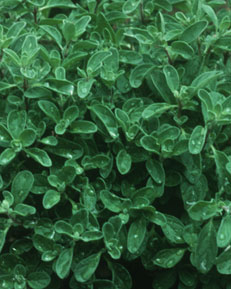
Photo © Steven Foster
Introduction
Marjoram is a bushy perennial shrub that is often grown as an annual depending on the climate.1,2 The shrub usually grows to about 1-2 feet in height with soft, fuzzy leaves.1 Marjoram originated in Asia Minor, but is cultivated in Mediterranean countries, Central and Eastern Europe, and the United States.2 The aromatic leaves are said to have a slightly bitter smell, but a taste that is described as sweeter and more delicate than oregano.3 History and Cultural Significance
Traditionally, ancient Greeks made wreaths out of marjoram for both funerals and weddings because it was thought that the Greek goddess of love, Aphrodite, created marjoram as a symbol of happiness.4,5 It was also believed that if marjoram was seen growing on or near a gravesite, the person buried there would have eternal happiness in the afterlife.4 Historically, marjoram was used to treat anxiety,6 headaches, insomnia,6 decreased appetite, problems with digestion, and menstrual disturbances.3 Marjoram was also used in combination with other ingredients for healthy restful sleep.7 As a culinary herb, marjoram is used in a variety of Mediterranean dishes including grilled meats and sauces.1 Marjoram oil, which is extracted through steam distillation of the juice of the crushed leaves, is found in a variety of soaps, cosmetics, and candles.3 The leaves of marjoram are also dried and combined with other soothing herbs and stuffed into pillows to promote restful sleep.5 Modern Research
Currently no clinical studies are available on the internal or external use of marjoram. Recent research has demonstrated that marjoram oil can extend the shelf life of packaged fish by inhibiting detrimental organisms.8,9 Future Outlook
Currently there is no information available on the market statistics or sustainability of Oregano majorana. References
1 Leung AY and Foster S, eds. Encyclopedia of Common Natural Ingredients Used in Food, Drugs, and Cosmetics. 2nd ed. New York: John Wiley and Sons Inc; 1996. 2 Katzer G. Marjoram Gernot Katzer’s Spice Pages.1999. Available at: http://www-ang.kfunigraz.ac.at/~katzer/engl/generic_frame.html?Maio_hor.html. Accessed April 1, 2005. 3 Bown D. New Encyclopedia of Herbs and Their Uses. London: Dorling Kindersley Ltd.; 2001. 4 Grieve M. A Modern Herbal, Vol. 2. New York: Dover Publications Inc.; 1971. 5 Cristman S. Origanum majorana. Floridata Marketplace Website. 2005. Available at: http://www.floridata.com/ref/O/orig_maj.cfm. Accessed April 12, 2005. 6 Chevallier A. The Encyclopedia of Medicinal Plants. London: Dorling Kindersley Ltd.;1996. 7 Jellin JM, Gregory PJ, Batz F, Hitchens K, eds. Natural Medicines Comprehensice Database. 5th edition. Stockton, CA: Therapeutic Research Faculty; 2003. 8 Mejlholm O, Dalgaard P. Antimicrobial effect of essential oils on the seafood spoilage micro-organism Photobacterium phosphoreum in liquid media and fish products. Lett Appl Microbiol. 2002;34(1):27-31. 9 Friedman M, Henika PR, Mandrell RE. Bactericidal activities of plant essential oils and some of their isolated constituents against Campylobacter jejuni, Escherichia coli, Listeria monocytogenes, and Salmonella enterica. Food Prot. October 2002;65(10):1545-1560.
|